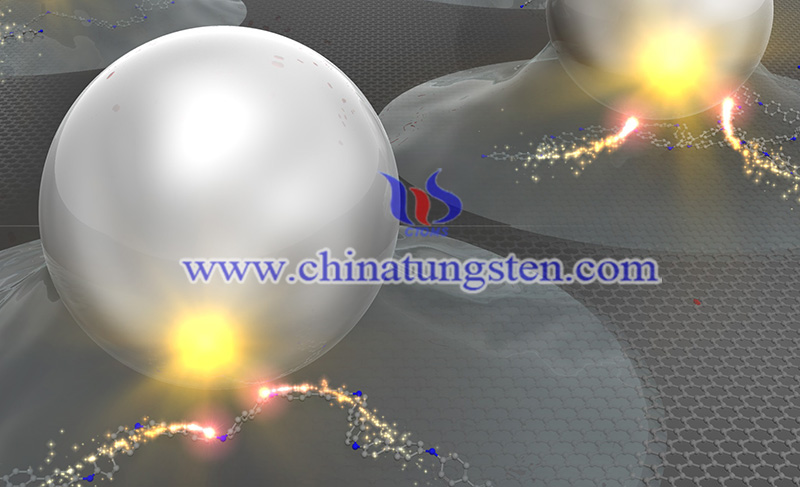Electrochemical Deposition for Fabricating SACs, Such as Molybdenum and Cobalt
- Details
- Category: Tungsten's News
- Published on Tuesday, 24 March 2020 22:33
Electrochemical deposition is a universal route for fabricating single-atom catalysts (SACs), such as molybdenum and cobalt catalysts, recently, the research team of Professor Jie Zeng and Associate Professor Shiming Zhou of the National Research Center for Physical Sciences at the Microscale and Department of Chemical Physics of the University of Science and Technology of China (USTC) have developed the electrochemical deposition method for preparing monoatomic catalysts
The researchers successfully prepared 34 kinds of a single atom, covering wide of transition metals and substrates such as molybdenum, cobalt, and manganese. Related results were published in Nature Communications.
SACs have achieved extensive attention in chemical reactions such as hydrolysis, oxygen reduction, carbon dioxide hydrogenation, and methane conversion due to their maximum atom utilization and unique electronic structure. While, the current methods for synthesizing monoatomic catalysts have relatively high requirements for mono-atoms and substrates, and they are not yet capable of preparing any metal monoatomic catalysts on any substrate. Therefore, the general non-selective substrate and metal catalysts have been developed, the method of adaptive monoatomic synthesis is of great significance.
Researchers at the USTC carried out electrochemical deposition under an electrochemical three-electrode system and obtained two types of Ir1/Co(OH)2 monoatomic catalysts through cathode deposition and anode deposition. Through the X-ray absorption fine structure spectrum, it was found that the two Ir single atoms obtained by cathode and anode deposition have different valence states and coordination environments. Further research showed that this difference is caused by different deposition species during the cathode and anode deposition processes as well as the different redox reactions that occur on the cathode and anode.

Besides, the team explored the effects of deposition conditions (precursor concentration, number of deposition cycles, and deposition rate) on the formation of single atoms, and found that when the metal loading is below a certain limit, single atoms can be obtained. When above limits, metal clusters or particles are formed. This change is similar to the nucleation process of crystal growth in the liquid phase. To prove the universality of the method, the researchers successfully obtained monoatomic catalysts covering 3d, 4d, and 5d metals on substrates of cobalt hydroxide, molybdenum sulfide, manganese oxide, and nitrogen-doped carbon. After characterizing the structure of the single-atom catalyst, it was found that the same single-atom catalyst obtained by cathode and anode deposition had different electronic structures, which provided the possibility for its application in different catalytic reactions.
The researchers also studied the performance of the obtained monoatomic catalysts in electro-catalytic water splitting reactions. The results showed that some of the catalysts obtained by cathode deposition showed excellent performance in the electro-catalytic hydrogen evolution reaction, especially the iridium monoatomic catalyst supported on the cobalt selenide substrate can obtain 10 with only 8mV over-potential m/cm2 current density. Meantime, some catalysts obtained by anodic deposition also showed great performance in the electro-catalytic oxygen evolution reaction.
Researchers further deposited iridium single-atoms on cobalt-iron selenide substrates grown on foamed nickel through cathode and anode deposition and used them as cathodes and anodes for electro-catalytic total hydrolysis reactions, respectively. Electrochemical tests show that the system only needs a potential of 1.39V to obtain a total hydrolysis current density of 10mA/cm2, breaking the record of the lowest potential in alkaline electrolytes.
This universal method for preparing SACs, such as molybdenum and cobalt catalysts, not only injected new vitality into the field of monoatomic catalysis but also provided new ideas for the systematic study of the relationship between catalyst structure and performance in the future.
| Molybdenum Supplier: Chinatungsten Online www.molybdenum.com.cn | Tel.: 86 592 5129696; Fax: 86 592 5129797;Email:sales@chinatungsten.com |
| Tungsten News & Prices, 3G Version: http://3g.chinatungsten.com | Molybdenum News & Molybdenum Price: http://news.molybdenum.com.cn |



 sales@chinatungsten.com
sales@chinatungsten.com